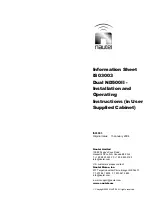
Dual ND500II (User Supplied Cabinet) – IS03003
Page 1
Information Sheet
Issue 1.0
IS03003 Dual ND500II (User Supplied Cabinet)
Information Sheet
1. INTRODUCTION
This document identifies the information
specific to a dual (main/standby) ND500II
radiobeacon transmitter system installed in a
user supplied cabinet. It also provides the
electrical parts list and point-to-point wiring
information for the dual transmitter system.
Information provided includes theory of
operation, installation, start-up and
calibration/testing procedures, parts list,
wiring list, electrical schematics and
mechanical drawings (including dimensions).
2. CABINET REQUIREMENTS
The user supplied cabinet must be able to
house two ND500II radiobeacon transmitters
and an interface assembly (plus an optional
remote control unit if desired). The upper
transmitter is designated as transmitter A
(unit 1), while the lower transmitter is
designated as transmitter B (unit 2). The
Nautel supplied equipment includes:
-
two ND500II radiobeacon transmitters
-
a dual transmitter interface assembly
(unit 3)
-
a computer remote control unit (unit 4,
optional)
- interconnecting
wiring
Refer to figures 2 and 3 for electrical
schematics of the dual transmitter system.
Refer to figure 4 for recommended
equipment layout.
3. THEORY OF OPERATION
The theory of operation presented in the
ND500II instruction manual describes the
operation of both transmitters A (ND500II-
11x-x2x) and B (ND500II-01x-x2x). The
following provides a brief description for
transmitters that are connected in a
main/standby dual installation. See figure
2A or 2B for interconnecting detail. See
figure 3 for the electrical schematic of the
dual transmitter interface PWB (3A1).
3.1 Normal Operation:
When the ‘main’
transmitter, selected by
MAIN XMTR A/B
switch 3S2, is turned on and producing a
satisfactory RF output, the following will
occur:
(a)
+15V will be applied from the main
transmitter (1A11J4-13 or 2A11J4-13),
through the dual transmitter interface
PWB (3A1J4-11 or 3A1J5-19) to the
standby transmitter (1A11J4-20 or
2A11J4-20), as the 'standby off'
control signal.
(b)
If transmitter A is selected as the
'main' transmitter, the main/standby
relay in transmitter A's harmonic filter
will be energized and will connect
transmitter A’s output to the antenna
system.
(c)
If transmitter B is selected as the
'main' transmitter, the main/standby
relay in transmitter A's harmonic filter
will be de-energized and transmitter
B’s output will be connected to
the
antenna system.
(d)
The selected 'main' transmitter will
p15V and the manually
controlled slewing commands
(
ATU
CONT
)
for the antenna system's
antenna tuning unit via the dual
transmitter interface assembly (unit 3).
(e)
The selected 'main' transmitter will be
providing the 'audio out'
(
RMT AUD
)
sample via the dual transmitter
interface assembly (unit 3).
(f)
If transmitter A is selected as the
'main' transmitter, an open collector
SHTDN ALM
(
B
)
signal will be applied to
3A1J5-23 from A11J4-17 ('shutdown')
of transmitter B.

















